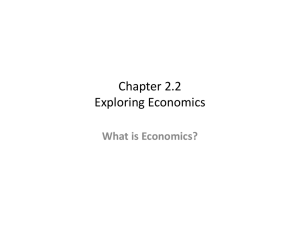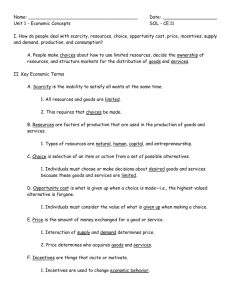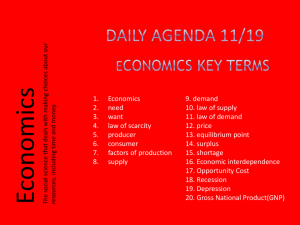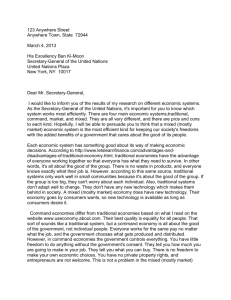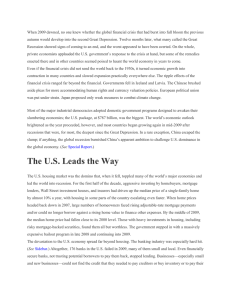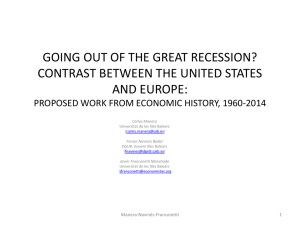Unit 2 - Economics - Holland Public Schools
advertisement
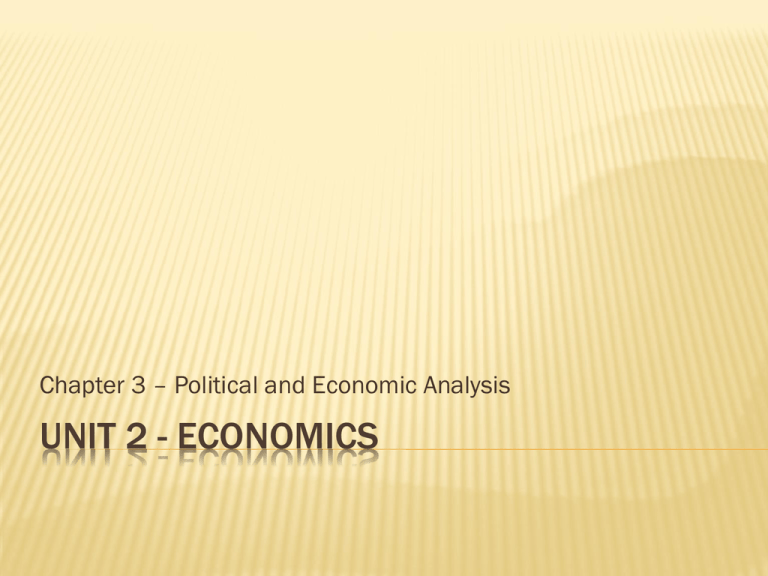
Chapter 3 – Political and Economic Analysis UNIT 2 - ECONOMICS 3.1 WHAT IS AN ECONOMY? The organized way a nation provides for the needs and wants of its people. A nation chooses how to use its resources to provide and distribute good and services A country’s resources determine economic activities such as manufacturing, buying, selling, transporting, and investing. RESOURCES Resources All the things used in producing goods and services Economists use the term Factors of Production when they talk about resources The factors of production comprise 4 categories: Land, Labor, Capital, and Entrepreneurship LAND Land includes everything contained in the earth or found in the seas. Ex. Coal and Crude Oil are natural resources Natural resources are used as raw material for making goods and creating services that are marketed to customers. Climate and geography can also be an example LABOR Labor refers to all the people who work. It includes: Full/part time Managers Professionals in both private and public sectors Economies with well trained, well educated labor have an advantage over other nations in attracting business CAPITAL Includes money to start and operate a business. Also includes the goods in the production process INFRASTRUCTURE Capital includes infrastructure Which is the physical development of a country Includes roads, ports, sanitation, facilities, and utilities, especially telecommunications ENTREPRENEURSHIP Refers to the skills of people who are willing to invest their time and money to run a business They organize factors of production to create the goods and services that are part of an economy ECONOMICS AND THE SHOPPING MALL The local shopping mall is a good place to observe economic principals. Labor is represented by salespeople Capital is the money that was invested in manufacturing products and selling them What are examples of the other 2 factors of production (land and entrepreneurship)? SCARCITY The difference between wants and needs and available resources HOW DOES AN ECONOMY WORK? Nations must answer three basic questions when deciding how to use their limited resources. Which goods and services should be produced? How should the goods and services be produced? For whom should the goods and services be produced? Dubai Example Location 60 Minutes Video Pictures TRADITIONAL ECONOMIES Traditions and rituals answer the basic questions of what, how, and for whom. Answers are also based on: Cultural Religious practices ideals (passed from one generation to the next) MARKET ECONOMIES There is no government involvement in economic decisions The government lets the market answer the three basic economic questions What How For Whom COMMAND ECONOMY A country’s government makes economic decisions and decides what, when, and how much will be produced and distributed. The government controls the factors of productions and makes all decisions about their use. CAPITALISM Marketplace competition and private ownership of business Government is concerned about People Cares for those that cannot care for themselves United States and Japan are examples COMMUNISM Government controls the factors of production No private ownership of property or capital The theory Goods owned in common are available to all as needed Very few left Cuba, North Korea, and China are examples SOCIALISM Originally referred to a system that was on its way to turning communist. The main goal is to meet basic needs for all and to provide employment for many Canada, Germany, and Sweden 3.2 UNDERSTANDING THE ECONOMY The Economy and Marketing If you are a marketer and you want to perform a useful SWOT analysis you need to consider the economic factors that will influence your marketing plan. WHEN IS AN ECONOMY SUCCESSFUL? A healthy economy has three goals: Increase productivity Decrease unemployment Maintain stable prices All nations analyze their economies to keep track of how well they are doing How is the US economy now? PRODUCERS AND CONSUMERS A nation's economy is the production and consumption of goods (food, clothes, cars) and services (repairs, lawn-mowing, haircuts) in that nation Anybody producing or consuming things in a country plays some role in the economy. Production and consumption are intertwined. SUPPLY AND DEMAND The ultimate goal of producers is to make money Consumers may want to satisfy their wants and needs by buying products Producers are the ones who actually set prices, but they do so based on the behavior of consumers. SUPPLY AND DEMAND CONT. If nobody buys a product at a particular price, the producer knows the price is too high. If some consumers buy it, but not enough to buy everything produced, producers must either decrease the price or decrease the supply. SUPPLY AND DEMAND CONT. The willingness of consumers to pay for products is known as demand. Even if there is constant high demand for a product (toilet paper, for example), individual producers need to keep the price down or consumers will just buy it from a competitor. BUSINESS CYCLE The recurring changes in economic activity Expansion When the economy is flourishing, sometimes referred to as a period of prosperity Recession A period of economic slowdown that lasts for at 6 months Depression A period of prolonged recession RECESSION A recession is a prolonged period of time when a nation's economy is slowing down, or contracting. Such a slow-down is characterized by a number of different trends, including: People buying less stuff Decrease in factory production Growing unemployment Slump in personal income An unhealthy stock market By the conventional definition, this slow-down has to continue for at least six months to be considered a recession. ASSIGNMENT Page 69 #21-25 Page 70 #29-30 THE GREAT DEPRESSION Video - American History: America's Economy: Sorrow and Hope Questions: What were some causes of the great depression? What happened to the residents of the dust bowl?

